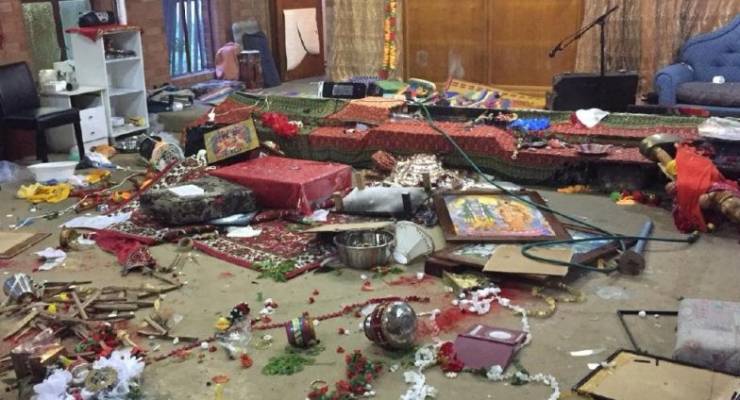
This month, vandals attacked a Hindu temple in the South Western Sydney suburb of Regent’s Park destroying statues and musical instruments, setting fire to parts of the temple, and writing the word “Jesus” on a wall.
The incident appears to be yet more evidence that Australia has not been untouched by the global resurgence in racist violence, which also saw the murder of 11 worshippers at a synagogue in Pittsburgh last weekend. But while Robert Bowers, the suspect in the mass shooting, faces federal hate crimes charges, NSW police recently refused to characterise the temple incident as a hate crime, despite community suspicions.
Of course, there are significant differences between the Pittsburgh shooting and the temple attack, about which little is known. Still, the incident points to a broader problem with how we deal with hate crimes in Australia, where a lack of available data, coupled with an ad hoc legal framework that varies from state to state, means it is incredibly difficult to quantify and understand the impact of the reactionary turn at home.
What is a hate crime in Australia?
Generally, hate crimes are understood to be crimes motivated by bias, prejudice or hostility towards a victims based on their particular characteristics, such as race, gender, sexuality or gender identity.
The problem in Australia, says Gail Mason, professor of Criminology at the University of Sydney and coordinator of the Australian Hate Crime Network, is the lack of a robust legal framework for dealing with hate crime.
“There is no one legal definition of hate crime in Australia”, Mason said.
Most Australian states don’t have laws which treat hate crimes as a separate offence. Instead, an offender’s hatred or prejudice towards a victim is dealt with by judges as an aggravating factor at sentencing. This means police cannot actually charge someone with a hate crime.
The one notable exception to the sentencing-based approach is Western Australia, where there are specific offences for racist hate crime. These laws are rarely used and, when they are, are controversially applied — the first person to be charged under the WA legislation was an Indigenous teenager who swore at a white woman.
Are we behind the curve?
Australia’s approach to hate crime is particularly inadequate when compared to other jurisdictions. Mason says the difference between treatment of hate crime in Australia and the United Kingdom, which is believed by experts to have the strongest framework, is stark.
“In the UK you have quite extensive hate crime laws, very extensive education, data recording, analysis, and community engagement.” said Mason
Similarly, in the US, hate crimes are recognised in both state and federal law.
In both the UK and the US, data indicates that hate crimes have skyrocketed since the populist explosion that launched Donald Trump into the Oval Office. In Australia, the treatment of hate crime at sentencing means there is scant data to match this.
“We don’t know whether or not there’s a spike in hate crime in Australia, because we don’t have reliable data”, said Mason.
What does that mean for law enforcement?
The law also leads to a poor understanding of hate crimes among police forces
“In Australia, one of the problems is there are no hate crime laws, which means police can’t charge people with hate crimes, so they haven’t taken a more proactive approach”, said Mason.
This means police forces tend not to be very good at identifying hate crimes when they occur. It also means victims of such incidents are very unlikely to come forward, or define what happened to them as a hate crime.
Dave McDonald, a criminologist at the University of Melbourne believes there is a lack of understanding within police forces of the spectrum of behaviour which can constitute a hate crime.
“It’s important to say that hate crime manifests in ways that are not recognised as hate, but as more trivial property offences. They might appear fairly benign at one level, but often they’re motivated by prejudice”.
The Hindu temple incident is a case in point.
“Without knowing the specifics, that sounds like a curious description by police”, McDonald said.
Against the backdrop of a resurgent global right, this chronic lack of understanding is particularly troubling.
“Australia is not immune to the rise of far right violence. What’s lacking is an appreciation of how widespread and prevalent, and the fact it is increasing in many ways”, McDonald said.
Until we get stronger laws, and better data, Australia will struggle to adequately grapple with a rise in racist violence.
“I certainly think its a problem because we don’t know what the problem looks like. We have no way of knowing whether there’s a spike. We don’t know what the patterns are, and what to do about it”, Mason said.








What there is is an increasing little claque of right wing lousy politicians who legitimise it as Trump as done. The LNP did the same with their idiot Hanson vote. Not only the alt right, but the so called conservative scum who do not call them out or encourage them. Abbot, Abetz, Dutton Hanson Katter et al.
Seriously – “the temple attack, about which little is known” is what one might deplore from the mudorc rags.
Wow, someone wrote (? spraycanned? copperplate script with a goose quill?) Jesus on a wall. This is beyond satire.
Just what we don’t need, yet another ID politics crime – that’ll really put paid to the racists & bigots.
A crime is clear cut – introducing ideology & speshal pleading benefits no-one except the perpetrators who can then claim oppression for their schism. Like Blot’s 18(d) – negligent fact checking – conviction which he consistently claims to have been under 18(c).
PS – after 6 quotes (the majority of the ‘expert’ opinion sought) from Mason comes the kicker – ““I certainly think its a problem because we don’t know what the problem looks like. We have no way of knowing whether there’s a spike. We don’t know what the patterns are, and what to do about it”, but that’s no reason not to get our knickers in a knot.
Oh – so an absence of “robust legislation” is the problem – according to an “expert”! We could have a chimpanzie type 18(z) and the matter would not be solved. The criminologist OUGHT to be aware that sanctions have little deterrent of crime (per se) but the likelihood of apprehension is a very good suppressor of crime.
Secondly, just what would MacDonald use as evidence to support his assertions? Pity the author of the article did not have the wit to ask.
If we’re stumbling about for a good case study of intolerance consider the career of South Africa since the whites have had the shunt. Flicking the whites was to solve the problem. Ditto for Zim. The last incident of the vandalism of trains, in S.A., is just the tip.